Stepping out under a clear night sky offers one of the most profound experiences: connecting with the cosmos. For centuries, humans have been fascinated by distant stars, planets, and galaxies. While the naked eye reveals wonders, a telescope to look at stars transforms this passive observation into an active exploration. It’s more than just a piece of equipment; it’s a gateway to understanding the universe and our place within it. If you’re eager to delve into the depths of space, finding the right telescope is your first crucial step.
Choosing the ideal telescope to look at stars can feel daunting, especially with the vast array of options available. Whether you’re a complete novice dreaming of seeing Saturn’s rings for the first time or an experienced astrophotographer seeking pinpoint clarity, there’s a telescope designed for you. This guide delves into some of the top recommended telescopes in 2025, exploring their features, strengths, and what makes them stand out, ensuring you find the perfect instrument to begin or continue your celestial journey. Understanding the basics, like the different types of telescopes and key specifications, is vital when selecting a star watching telescope.
Best Telescopes We Recommend for Stargazing in 2025
Exploring the night sky requires an instrument that matches your needs and aspirations. Here are some of the best telescopes reviewed, catering to various skill levels and interests.
Best for Beginners: Celestron NexStar 4SE
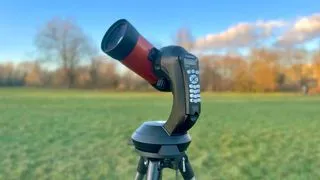
The Ultimate Guide to What to Eat in Austin Texas
Your Guide to the Michigan Map with Cities – Unlocking the Great Lakes State
Ultimate Guide to Weekend Trips From Las Vegas
The celestron nexstar 4se set up outside in a field, a great telescope to look at stars for beginners
The Celestron NexStar 4SE is often hailed as an excellent starting point for those new to the hobby, making it a fantastic telescope to look at stars effortlessly. Its computerized mount, featuring Celestron’s SkyAlign technology, simplifies finding celestial objects. You don’t need prior knowledge of constellations; simply input the date, time, and location, and the telescope can automatically locate targets for you.
This Maksutov-Cassegrain telescope boasts a 4-inch (102mm) aperture and a long 1325mm focal length, providing sharp views of planets and the moon. While its narrow field of view means larger deep-sky objects might not fit entirely, it excels at bringing brighter celestial bodies into focus. It’s a sturdy scope, though at 23 lbs (10.4 kg), not the most portable, making it ideal for backyard stargazing. The need for a reliable external power source is a key consideration, as it can quickly drain AA batteries.
Best Budget Telescope: Celestron Inspire 100AZ Refractor
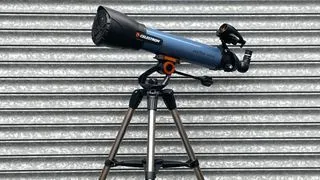 A side profile view of the Celestron Inspire 100AZ telescope against a corrugated iron backdrop, an affordable telescope to look at stars
A side profile view of the Celestron Inspire 100AZ telescope against a corrugated iron backdrop, an affordable telescope to look at stars
For beginners looking for an affordable yet capable option, the Celestron Inspire 100AZ is a strong contender as an entry-level telescope to look at stars. This achromatic refractor is easy to set up and use, offering clear views of the moon and planets with its 4-inch (100mm) aperture and 660mm focal length.
One notable feature is the innovative lens cap that doubles as a smartphone adapter, allowing users to easily capture basic images of the night sky. It comes with essential accessories like eyepieces and a red LED flashlight for maintaining night vision. While there might be some minor chromatic aberration (false color) and blurring at the edges, these are often acceptable trade-offs for the price, and upgrading eyepieces can enhance the experience. This telescope is lightweight and portable, though it lacks GoTo technology, requiring the user to locate objects manually or with assistance from stargazing apps.
Best Value for Enthusiasts: Celestron Astro Fi 130
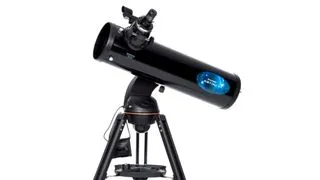 The Celestron Astro Fi 130 on a white background, a versatile amateur telescope
The Celestron Astro Fi 130 on a white background, a versatile amateur telescope
Offering a great balance of features and price, the Celestron Astro Fi 130 is an excellent value proposition for enthusiastic beginners or intermediate stargazers. This Newtonian reflector features a 5.19-inch (130mm) aperture and a 650mm focal length.
Its key selling point is the integrated WiFi and compatibility with the Celestron SkyPortal app, transforming your smartphone or tablet into a wireless controller and star map. The app simplifies alignment and can even recommend objects visible based on your location, making it a user-friendly telescope amateur astronomers can quickly get to grips with.
While the included accessories are basic, upgrading eyepieces is recommended to maximize its potential. It’s relatively portable and offers good views of planets, the moon, and even some brighter deep-sky objects like the Andromeda Galaxy. Battery drain in cold weather is a potential drawback, suggesting the need for an external power source. You can find great deals on top 10 amatuer telescopes like this one when looking to enhance your stargazing experience.
Best Premium: Celestron NexStar Evolution 9.25
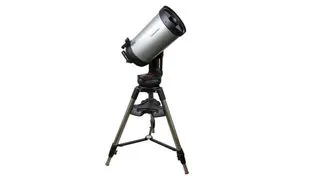 The Celestron NexStar Evolution 9.25 on a tripod on a white background, a high-quality telescope for serious stargazing
The Celestron NexStar Evolution 9.25 on a tripod on a white background, a high-quality telescope for serious stargazing
For serious enthusiasts or experienced astronomers seeking top-tier performance, the Celestron NexStar Evolution 9.25 is a premium choice. This Schmidt-Cassegrain telescope features a large 9.25-inch (235mm) aperture and a long 2350mm focal length, delivering exceptionally crisp and detailed views across a wide range of celestial targets.
The motorized alt-azimuth fork arm mount is highly stable and features a built-in rechargeable lithium-ion battery offering up to 10 hours of power – a significant advantage. Like other NexStar models, it integrates seamlessly with the SkyPortal app for easy GoTo capabilities and tracking, making it suitable for both visual observation and astrophotography. Despite its outstanding optical quality and features, its significant weight (62.60 lbs / 28.39kg) makes it less portable, best suited for a permanent setup or backyard use. An amatuer telescope of this caliber offers stunning views and capabilities.
Best for Astrophotography: Celestron Origin Intelligent Home Observatory
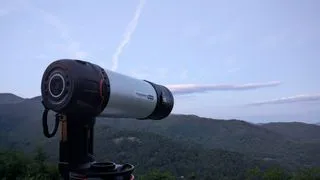 a black and white telescope in a field, optimized for astrophotography to look at stars
a black and white telescope in a field, optimized for astrophotography to look at stars
The Celestron Origin breaks the mold of traditional telescopes by featuring a built-in camera instead of an eyepiece. This smart telescope is designed specifically for capturing stunning images of deep-sky objects, even from light-polluted areas. Using Rowe-Ackermann Schmidt Astrograph (RASA) optics, it takes crystal clear photos in seconds by automatically stacking multiple exposures.
Operated entirely via an intuitive app, it automates setup, focusing, and tracking. While it excels at imaging nebulas and galaxies, its performance for planets might require more refinement. It’s a high-tech, albeit pricey (around $4,000), solution best suited for astrophotographers who prioritize ease of use and image quality over traditional eyepiece viewing. Its size and weight (41.6 lbs / 18.6 kg) also make it less portable. This is not a standard telescope to look at stars through an eyepiece, but a powerful imaging tool.
Best Motorized Telescope: Celestron NexStar 8SE
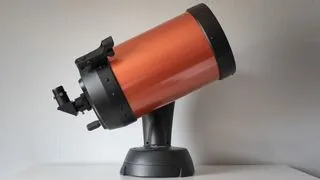 Celestron NexStar 8SE review photo, a popular motorized telescope to look at stars
Celestron NexStar 8SE review photo, a popular motorized telescope to look at stars
Dubbed “The World’s Most Beloved Telescope,” the Celestron NexStar 8SE is a highly versatile motorized scope suitable for all experience levels. Its 8-inch (203mm) Schmidt-Cassegrain optics gather substantial light, providing bright, detailed views of objects within and beyond our solar system.
The computerized alt-azimuth fork arm mount simplifies navigation using the handheld remote, offering access to a vast database of celestial objects or an automated “sky tour.” The smooth and accurate tracking makes it an excellent candidate for astrophotography. Its relatively compact “orange tube” design contributes to its portability compared to larger scopes, though it still weighs 32 lbs (14.48kg). The main drawback is its reliance on 8 AA batteries, strongly recommending rechargeable options or an external power source for extended use. This amateur telescope strikes a great balance between power and ease of use.
Best for Portability: Celestron Astro Fi 102
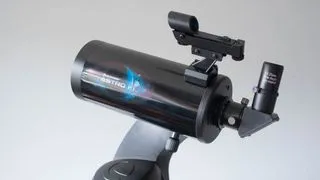 The Celestron Astro Fi 102, a lightweight telescope to look at stars on the go
The Celestron Astro Fi 102, a lightweight telescope to look at stars on the go
For stargazers on the move, especially those in urban areas needing to escape light pollution, the Celestron Astro Fi 102 is a top portable choice. Weighing only 6 lbs (2.7kg) with a compact body, this Maksutov-Cassegrain scope is incredibly easy to transport.
It features integrated WiFi and pairs with the Celestron SkyPortal app, providing access to a large database of celestial objects and automated GoTo capabilities. While the optics are good enough for viewing the moon and brighter planets, sharpness can drop off at the edges, and the included tripod feels somewhat flimsy. Despite not having a premium feel and needing protection from the elements, its affordability and portability make it an accessible telescope to look at stars from various locations.
Best for Accessories: Sky-Watcher Skymax 150 PRO
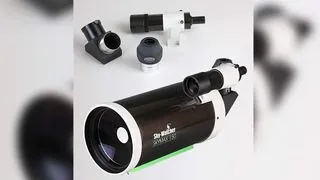 The Sky-Watcher Skymax 150 and accessories laid on a white table, a telescope designed to accommodate many accessories
The Sky-Watcher Skymax 150 and accessories laid on a white table, a telescope designed to accommodate many accessories
A favorite among astrophotographers and experienced observers, the Sky-Watcher Skymax 150 PRO stands out for its outstanding optical quality and ability to accommodate numerous accessories. This Maksutov-Cassegrain telescope features a 5.9-inch (150mm) aperture and a long 1800mm focal length.
Often paired with an equatorial mount (though some models don’t include a tripod/mount), its relatively lightweight (13.23 lbs / 6kg) design makes it portable enough for trips to dark sky sites. The smooth focuser and sharp, distortion-free views are ideal for capturing everything from planets to distant nebulas. With a Vixen-style dovetail plate, it easily accepts CCD or DSLR cameras, filter wheels, and other add-ons, making it a versatile tool for serious astrophotography. This amateur telescope is built for expansion and high-quality imaging.
Best Smart Telescope: Unistellar eQuinox 2 telescope
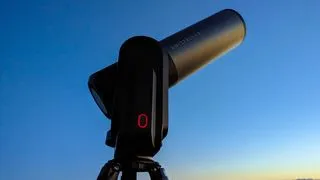 Telescope in-use against night sky, an advanced smart telescope to look at stars via app
Telescope in-use against night sky, an advanced smart telescope to look at stars via app
Representing the cutting edge of astronomical technology, the Unistellar eQuinox 2 is a smart telescope that replaces the traditional eyepiece with a high-resolution camera and a sophisticated app interface. This motorized GoTo alt-azimuth reflector uses a 6.2MP image sensor to capture and stack images in real-time, revealing stunning views of deep-sky objects on your mobile device within minutes.
Its standout feature is the Smart Light Pollution Reduction, which allows for impressive observations even from brightly lit urban environments. Setup is simplified by Autonomous Field Detection. While its image resolution is not the highest for single shots, the stacked images provide significant detail. Priced around $2,000, it’s a significant investment but offers unparalleled ease of use and the ability to share images instantly. This is a unique way to look at stars without physically looking through a lens.
Best for Deep Space: Celestron Advanced VX 8 EdgeHD
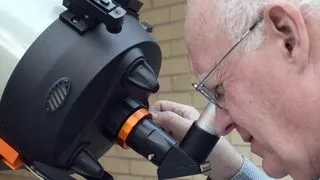 Review photo of the Celestron Advanced VX8 Edge HD, a powerful telescope for deep space views
Review photo of the Celestron Advanced VX8 Edge HD, a powerful telescope for deep space views
Designed for serious amateur astronomers and astrophotographers, the Celestron Advanced VX 8 EdgeHD excels at providing sharp, detailed views across the entire field of view, particularly beneficial for deep-space objects. This Schmidt-Cassegrain telescope incorporates EdgeHD technology to correct field curvature, ensuring stars appear pinpoint sharp even at the edges of the image sensor.
Its robust motorized equatorial mount (Advanced VX) is designed for stability and precision tracking, crucial for long-exposure astrophotography. With an 8-inch (203.2mm) aperture and 2032mm focal length, it gathers ample light to reveal intricate details in nebulas, galaxies, and globular clusters. While setting up an equatorial mount requires some astronomical knowledge, its performance and optical quality make it a telescope you won’t quickly outgrow. It can handle up to 30 lbs (13.6kg) of equipment, supporting cameras and other accessories.
Best for Kids: Celestron FirstScope 76 Tabletop telescope
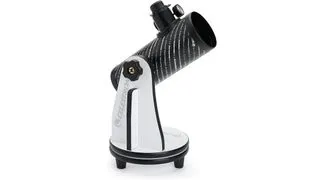 Celestron FirstScope on a white background, a simple telescope to look at stars for kids
Celestron FirstScope on a white background, a simple telescope to look at stars for kids
Introducing young astronomers to the wonders of the night sky is easy with the Celestron FirstScope 76. This low-cost, portable tabletop reflector telescope is designed with simplicity and ease of use in mind, making it a great first telescope to look at stars for children.
It comes fully assembled and ready to use right out of the box. Its 76mm aperture and fast focal ratio (f/3.95) allow for decent views of the moon, planets, and some brighter deep-sky objects, providing that essential “wow factor.” Weighing only 4.5 lbs (2.04kg), it’s highly portable. While it doesn’t come with a finderscope (a helpful tool for locating objects) and the included eyepieces are basic, its robust build and low investment make it an excellent entry point into the hobby for casual viewing. Consider adding an inexpensive red dot finder to enhance its usability for kids.
Telescope FAQ
Choosing the right telescope to look at stars can be complex. Here are some frequently asked questions to help clarify common terms and considerations.
How do I choose the right telescope for me?
Selecting the ideal telescope to look at stars involves considering several factors. Firstly, your experience level is crucial – beginner telescopes prioritize ease of use, while advanced models offer more power and features but require more knowledge. Your budget will significantly narrow down options, as prices range widely. Think about what you want to observe: planets and the moon require different capabilities than faint deep-sky objects like galaxies.
Portability is key if you plan to travel to darker skies; larger, more powerful telescopes are often heavier and better suited for backyard use. Understanding the different types of telescopes (reflector, refractor, catadioptric) and their pros and cons is also vital. Finally, always purchase from reputable dealers who can offer advice and warranty support. An amateur telescope range often covers models for different beginner-to-intermediate needs.
What types of telescope are there?
There are three primary types of telescope to look at stars:
- Reflector Telescopes: Use mirrors to collect and focus light. The most common designs are Newtonian (with a primary and secondary mirror) and Dobsonian (a type of Newtonian on a simple alt-azimuth mount). They offer excellent value for aperture, meaning you get more light-gathering power for your money, making them great for observing fainter deep-sky objects. However, mirrors may require periodic alignment (collimation) and cleaning.
- Refractor Telescopes: Use lenses to bend (refract) light to form an image. They are known for providing sharp, high-contrast views and require little maintenance. Refractors are particularly good for observing the moon and planets. A drawback is that they can suffer from chromatic aberration (color fringing) around bright objects, especially cheaper models. Higher-end apochromatic refractors correct this but are expensive.
- Catadioptric Telescopes: Also known as compound telescopes, they use both mirrors and lenses to create a compact design with a long focal length. Schmidt-Cassegrain and Maksutov-Cassegrain are common types. They offer versatility, high magnification, and are often more portable than reflectors of similar aperture. Their sealed tubes require minimal maintenance. They are generally more expensive than reflectors or refractors of comparable size. Many computerized telescope amateur models fall into this category.
How does a refractor telescope work?
A refractor telescope to look at stars uses an objective lens at the front of the tube to gather and bend light towards the back. This light then passes through a star diagonal (which often provides a more comfortable viewing angle) and finally through an eyepiece, which magnifies the image. The design is straightforward and requires minimal maintenance as the lenses are typically sealed. They are intuitive to use, making them popular for beginners. Refractors mounted on simple alt-azimuth mounts are easy to move up/down and left/right to track objects.
They excel at providing clear, high-contrast images, making them ideal for detailed observations of the moon and planets. However, chromatic aberration can be a factor, causing colorful halos around bright objects.
How does a reflector telescope work?
A reflector telescope to look at stars, typically a Newtonian or Dobsonian, uses a large curved primary mirror at the bottom of the tube to collect and focus incoming light. This light travels back up the tube to a smaller, flat secondary mirror placed near the front. The secondary mirror diverts the light beam at a right angle out to the side of the tube, where the eyepiece is located. The eyepiece then magnifies this image. Reflectors offer excellent light-gathering power for their size and cost, making them great for viewing fainter deep-sky objects like galaxies and nebulas.
However, the mirrors need to be aligned periodically (collimated) to ensure the best image quality, and the open tube design can attract dust, requiring occasional cleaning. Setting up Newtonian reflectors on equatorial mounts can be more complex for beginners compared to simple alt-azimuth or Dobsonian mounts. Finding a good amatuer telescope often involves considering reflector designs.
How does a catadioptric telescope work?
A catadioptric telescope to look at stars combines the principles of both refractor and reflector telescopes. It uses a primary mirror at the back of the tube and a lens (either a corrector plate or a meniscus lens) at the front to correct optical aberrations and make the telescope more compact. Light enters through the corrector lens, is reflected by the primary mirror to a secondary mirror (often mounted on the inside of the corrector lens), and then directed back through a hole in the center of the primary mirror to the eyepiece at the rear.
This design results in a relatively short, portable tube with a long focal length, providing high magnification. Catadioptrics are versatile, performing well for viewing planets, the moon, and deep-sky objects, and are excellent for astrophotography due to their long focal lengths and often computerized mounts. Their sealed design requires less maintenance than open reflectors, but they are generally more expensive.
What is a finderscope?
A finderscope is a small, low-magnification telescope or sight attached to the main telescope to look at stars. Its purpose is to help you locate objects in the night sky more easily. Because the main telescope has a high magnification and a narrow field of view (showing only a small patch of sky), it’s difficult to aim it accurately at a specific target. The finderscope, with its much lower magnification and wider field of view, shows a larger area of the sky.
By centering the desired celestial object in the finderscope’s crosshairs or dot, you ensure that the object is also within the much narrower field of view of the main telescope’s eyepiece. There are different types, including straight-through, right-angle, and red dot finders, each offering different advantages depending on the telescope type and user preference. A star watching telescope often includes a basic finderscope.
What does aperture, magnification and focal length mean on a telescope?
- Aperture: This is the diameter of the telescope’s main light-gathering element – either the objective lens (refractor) or the primary mirror (reflector/catadioptric). It is the most critical specification. A larger aperture collects more light, allowing you to see fainter objects and providing higher resolution (finer detail).
- Focal Length: The distance from the main optical element (lens or mirror) to the point where the light is brought into focus. A longer focal length generally results in higher magnification for a given eyepiece, but also a narrower field of view. It’s usually measured in millimeters (mm).
- Magnification: How much larger an object appears through the telescope compared to the naked eye. Magnification is calculated by dividing the telescope’s focal length by the focal length of the eyepiece being used (Magnification = Telescope Focal Length / Eyepiece Focal Length). While high magnification seems desirable, it spreads the collected light over a larger area, making the image dimmer, and also magnifies atmospheric turbulence. Useful magnification is limited by the telescope’s aperture and atmospheric conditions.
Magnification: How do telescope eyepieces work?
Telescope eyepieces are interchangeable lenses that fit into the focuser of a telescope to look at stars and are responsible for magnifying the image formed by the telescope’s objective lens or primary mirror. Each eyepiece has its own focal length, typically marked in millimeters (e.g., 25mm, 10mm). The shorter the focal length of the eyepiece, the higher the magnification it provides when used with a specific telescope. For example, a 10mm eyepiece will yield twice the magnification of a 20mm eyepiece on the same telescope.
Astronomers use different eyepieces to change magnification, choosing lower powers for wide-field views (good for finding objects or viewing large star clusters/nebulas) and higher powers for detailed views of the moon, planets, or double stars (when atmospheric conditions allow). Having a range of eyepieces is essential for versatile observing.
